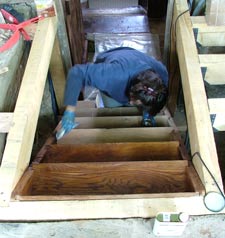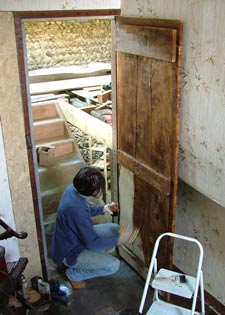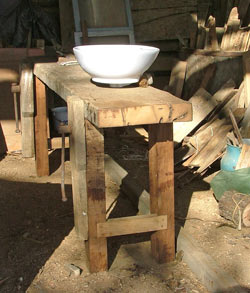April 2007
There have been enormous changes in our house since we last wrote. This partly
explains the fact that it has taken us four months to get an update out the door.

Perry had a relatively quiet period on the work front (hint, hint) and so chucked on his old
jeans and got stuck in to the renovations with Caroline. We are creating two bathrooms
and Perry's studio from an empty space at the back of the house.

The electrics and plumbing had finally been placed after at least twenty different
room layouts. Now Terry could lay the base plates.
English builder, Terry and his son, Simon, started laying the floor for the two bathrooms.
Special metal (Lewis) plates were covered in 6 cms of cement. Getting the cement up
to the first floor would have killed us if we'd done it by rope and pully, so we hired a lift on
rails. A complete wheelbarrow load could be sent up with the touch of a button. We did
have to first shovel the cement into the lift bucket, then reshovel it into buckets at the
top. But it saved a few visits to the physio.

It took three days to get all the cement up and spread across the two bathroom floors.
Without the lift it would have been a lot longer and more painful process.
One small hiccup was the fact that the metal plates allowed the water in the cement
to leak through into the new kitchen below. Pots, pans and buckets got most of it, but
seeing water pour down through the light fittings was a little disconcerting. Amazingly,
Caroline kept her cool managed to laugh it off, though we cooked by candlelight for the
next few days, until it dried out.

Monsieur Labourie shows us the tricks of the trade
A week later, a retired French mason came to show us how to mix chalk and sand (crépie)
and flick it onto the walls so that it stuck. M. Labourie is almost 70 and has been throwing chaux onto walls for 54 years. It looked so easy, until we tried it ourselves. A flick of the
wrist and a full trowel of crépie flew in any direction other than where we wanted it.
We ended up wearing most of it instead. M. Labourie is a serious comedian, telling jokes
and anecdotes non stop, with an infectious smile and a naughty twinkle in his eye.
We learnt all sorts of techniques, as well as some funny phrases in Patois, Spanish,
Arabic and Italian.

First, the old earth between the wooden colombage was brushed and hacked to remove
all the lose material. Then two layers of grey crépie. The third layer has a natural tint.
We proceeded to lay three layers of crépie on the walls. First two layers with grey sand
and the last layer with river sand, pigment and earth. The earth came from an old
colombage wall we had demolished earlier and then run through a large sieve.
It gave the crépie a natural, warm colour.

A 200 year-old wall of earth, straw and dust being broken down,
sieved and recycled
We discovered that the Marie had bought scaffolding for the people of the commune to use.
We hired enough to be able to reach 6 meters. Erecting the frames was tough and Perry overcame his vertigo to end up climbing up and down it like a chimpanzee. It will come in
handy when we need to joint and paint the plasterboard celings.


It's a long way down!... ...especially when there are no stairs

...thankfully Ernest was ready with the replacement,
made from old oak planks that we found...


...which had to be stained and varnished, along with the original poplar wood door.

The beginnings of the stud walls. The original earth and stone walls will cost too
much time and effort to renew and none are straight or 90 degrees to each other.
The cavities will allow us to insulate and put all the electrics and plumbing out of sight.

In the meantime Caroline cleaned up and varnished the old workshop bench that we found
in the barn, to give it a new life in the guest bathroom.

We mixed the crépie by hand, on the floor of the chai. The cement mixer stayed in the barn. Perry learnt to feel if the mix was 'trop maigre' or 'trop gras'.

M. Labourie showed us how to use bricks made from dried clay to fill gaps in the old wall.
We also used old, broken roof tiles, since they dry quicker than modern tiles.

The different walls and divisions were set out and then lined with waterproof plasterboard

The through-view gone, the separate bathrooms begin to take shape and we get to see if our calculations were correct (they were, phew!).The electrician fixed his cables and junction boxes, next comes the plumber, before we can insulate and close off the walls.

Our bathroom gets a lining. The radiator will slot into the gap shown.
Old terracotta tiles will lay across the shelf above.
A bientôt.
Our house archive
2005
March | April | June | August | October
2006
January | March | May | July | September | December
2007
April | August | December
©2007 Perry Taylor & La Baguette Magique
